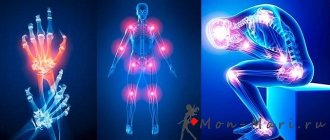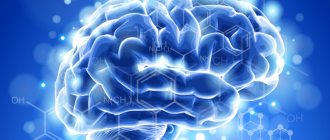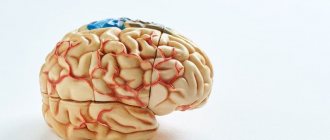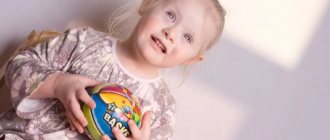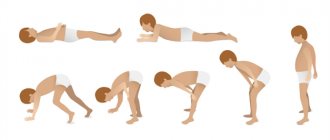Diseases of the nervous system in children caused by any microorganism always pose a threat to health and sometimes life. The causative agent can be any representative of the microcosm: bacteria, viruses, fungi, etc. The infectious process begins after the pathogen penetrates the nervous tissue or (which is less common) against the background of other diseases, including those of an infectious nature.
To prevent a child from developing nervous disorders, he should not be frightened, publicly scolded, or left alone in an unfamiliar environment.
Among all existing diseases, the following types are distinguished: meningitis, poliomyelitis, encephalitis.
Causes underlying diseases of the nervous system
- Heredity. There are cases in the family of patients with diseases of the nervous system, alcohol and drug addiction, and psychiatric diseases.
- Infectious diseases.
- Exposure to poisons and toxins (barbiturates, plant poisons, heavy metal poisoning)
- Stress, overwork, lack of sleep
- Psychotype of a child. Diseases of the nervous system are more common in children who are easily excitable, emotional
- Injuries causing concussions and bruises of the brain, ruptures of peripheral nerves.
- Tumors are malignant and benign.
- Vascular pathology.
- Causes of malnutrition (especially B vitamins and vitamin E).
Encephalitis
The inflammatory process in the tissues of the brain, both in children and adults, is called encephalitis. Depending on the nature, it can be viral (for example, tick-borne), secondary, and encephalomyelitis (often in newborns after suffering from influenza, rubella, etc.). General characteristic symptoms: rapid onset of the disease, changes in consciousness up to the development of coma, drowsiness, convulsions, the occurrence of paresis and meningeal symptoms. The child may have trouble breathing and blurred vision.
Children with suspected encephalitis are hospitalized and the following therapeutic measures are carried out. For tick-borne encephalitis, serum is administered; for encephalitis that occurs as a result of the administered vaccine, gamma globulin is administered and antibiotics are prescribed. According to indications, drugs are administered to eliminate convulsions, fever, and interruptions in heart function in newborns.
Any of the above symptoms requires immediate contact with a specialist. Otherwise, deterioration of the condition may lead to serious changes in the child's health or death.
Clinic and main symptoms of diseases of the nervous system.
In each age period, doctors identify certain criteria that determine the boundaries between pathology and normality.
The main symptoms of diseases of the nervous system:
- Movement disorders (paralysis, paresis), changes in posture, tremors, slow involuntary movements
- Headaches (simple migraine, chronic headache, cluster migraine)
- Loss of coordination of movements (dizziness, unsteadiness of gait, nausea)
- Impaired tactile sensitivity of certain parts of the body, impaired sense of smell
- Pain in the lower back and limbs, in the neck.
Polio
This is a disease of a viral nature, which is transmitted mainly through dirty hands, as well as through the air, and mainly affects some parts of the spinal cord. The hidden period lasts no more than 10 days. Symptoms of the disease in newborns depend on the stage of the disease. During the preparalytic period, general signs of intoxication and malaise are observed. Symptoms characteristic of damage to the nervous system: drowsiness, limb cramps, delirium, pain on palpation of the muscles of the limbs, etc.
During the paralytic period, typical paresis (partial paralysis) and paralysis (complete paresis) are observed. A severe form of the disease is accompanied by damage to vital centers of the brain, which can lead to the death of the child. During the recovery period, complete or partial recovery is noted. During the period of residual effects, symptoms of paralysis are observed, indicating damage to the nervous system.
Treatment boils down to immediate hospitalization and administration of gamma globulin.
It is possible to prevent this disease if you do not ignore mandatory vaccination.
Symptoms of polio depend on the stage of the disease.
Diagnosis of diseases of the nervous system.
In the diagnosis of diseases of the nervous system, anamnesis and examination of the child play an important role. Pay attention to orientation in time and space, to the functioning of the extraocular muscles, to gait, to movements in the joints, to reflexes, the child’s speech and the postures used by him.
If necessary, some instrumental studies are carried out - computed tomography, angiography, magnetic resonance and positron emission tomography, ultrasound. In some cases, it is necessary to resort to lumbar puncture. When examining patients with epileptic syndrome, electroencephalography is mandatory.
Types of neurotic reactions
Nervous tics
are one of the most common types of neurotic reactions in children. It is expressed by involuntary obsessive movements - twitching of the eyelid, cheek, shoulder; smacking, etc. These movements appear or intensify with excitement. As a rule, they do not appear at all if the child is in a good, calm mood. You cannot demand that your baby “stop” a nervous tic - these movements are involuntary and absolutely uncontrollable.
Neurotic stuttering
worries many children in preschool age, when they are actively developing speech. It is noteworthy that parents often attribute stuttering to problems with the speech apparatus, when in fact it is caused by neurology. For the majority, this type of stuttering goes away over time without any intervention, but still a certain percentage of children cannot get rid of this trouble for many years without the help of a specialist.
Sleep disorders
with neurological abnormalities, they are quite pronounced: the child cannot fall asleep, he is tormented by nightmares, he sleeps restlessly and may complain because of this of fatigue right in the morning.
Neurotic enuresis
- involuntary urination during night sleep in children over 5 years of age (before this age, enuresis is not considered a pathology). This trouble often occurs after punishment, overexcitation or nervous shock. Typically, children suffering from enuresis are characterized by unstable emotional behavior and tearfulness.
Various eating disorders
also refer to neurotic reactions. This can be either refusal of food or individual dishes, or obvious overeating. The difficulty is that preschool children have not yet formed eating habits, and they may suddenly become selective in food for reasons not related to neurology. Therefore, this symptom must be considered in conjunction with the child’s general behavior.
Treatment of diseases of the nervous system in children.
In the modern world, pediatric neurology is developing rapidly and uses the most effective methods for treatment. Complex treatment includes drug therapy, physiotherapy, massage, balneotherapy, consultations with psychologists and other specialists.
In the section devoted to diseases of the nervous system in children, we will consider the following diseases.
- Hunt's juvenile parkinsonism
- Intracranial hypertension (increased intracranial pressure)
- Cerebral palsy and other cerebral symptoms.
- Inflammatory diseases of the nervous system
- Myasthenia and myopathies
- Brain malformations
- Migraine and other types of headaches.
- Myelitis
- Seizures in children and epilepsy in children
- Dystonia, hypo and hypertonicity and other muscle tone disorders in children.
- Neuralgia and neuritis
- Neuropathy and polyneuropathy (neuritis, neuropathy)
- Neuroses, hysteria, neurasthenia
- Brain abscess
- Tumors (brain, spine)
- Polio
- Cerebrovascular disorders
- Extrapyramidal and other movement disorders.
- Encephalitis
- Encephalopathy
- Sleepwalking
Common pathogens of meningitis
Coxsackie viruses
The disease in a child caused by this virus can be in the form of outbreaks and is transmitted through food and air. After entering the body, the first signs are observed approximately 7 days later. This pathology begins, both in newborns and older children, with attacks of headache. Visually, the face, as well as the sclera of the eyes, become red. A rash in the form of spots is noticeable throughout the body. A sick baby is agitated and sleeps poorly. The course of this type of meningitis is benign. Contamination of the cerebrospinal fluid and an increase in body temperature lasts no more than 3 weeks.
Treatment consists of prescribing drugs that eliminate the symptoms, that is, antipyretics, painkillers and other drugs. If you are worried about a severe headache, then punctures may be recommended as prescribed by your doctor.
With the Coxsackie virus, the child experiences a rash all over the body.
Koch stick
Tuberculous meningitis caused by Koch's bacillus is almost always secondary, that is, it develops against the background of an existing infectious process. Characteristic symptoms: physical inactivity (decreased motor activity of the child), hyperthermia, lack of appetite, the appearance of symptoms that are characteristic of meningitis. Paresis (partial paralysis), drooping eyelids, and squint are possible.
When cerebrospinal fluid is collected, it flows out under increased pressure. Treatment consists of prescribing antibacterial drugs that have a detrimental effect on Mycobacterium tuberculosis. Phtivazid, Streptomycin, PAS are prescribed as etiotropic therapy.
Tuberculous meningitis in a child is accompanied by symptoms that are characteristic of meningitis.
Meningococcus
This virus is the cause of meningococcal meningitis in newborns. It affects not only the membranes of the brain, and is dangerous due to a special condition - sepsis (blood poisoning). It affects the eyes, skin, joints, and kidneys.
Children often get sick in the first three years of life. Characteristic signs of the disease include: deterioration in general health (fever, vomiting without nausea, anxiety, etc.). In newborns and children under one year of age, the fontanel is greatly bulging and meningeal signs are present.
The nature of the disease is confirmed by peculiar rashes with hemorrhage inside, shaped like small stars. They are slightly raised above the skin level and occur on the lower extremities and back. Over time, inflammation of the joints and membranes of the eyes is possible. If you take the cerebrospinal fluid, it is cloudy, it contains a high content of leukocytes, protein, as well as meningococci - the causative agents of the disease. They are also found in skin scrapings, as well as in intra-articular fluid.
The life expectancy for this type of meningitis is serious. Treatment consists of prescribing antibiotics: meningococcus is sensitive to penicillin. Along with it, sulfonamides and corticosteroid drugs can be prescribed.
The generalized form of meningococcal infection is meningococcal meningitis - a disease with severe course and
Treatment methods for ICP
When your child is given an imaginary diagnosis, namely because of one tantrum, then no medications are needed. Some time will pass and the pressure will normalize on its own. But if increased ICP is a serious concern for your child, the doctor may prescribe medications that remove excess fluid from the body.
If the diagnosis is correct, that is, it was made based on the course of such dangerous diseases as neuroinfection, serious head injury or congenital hydrocephalus, then no medications to reduce intracranial pressure will help. To solve such a serious problem, the direct participation of a neurosurgeon, traumatologist and resuscitator in the treatment process is necessary.
Symptoms of hypertension
Parents should be wary if after three months the child also continues to clench his hands into fists and bend his limbs. Pathological hypertonicity can manifest itself in different ways, and the symptoms depend on the tension of different muscle groups.
If neurological problems are identified in newborns, the symptoms of hypertonicity will be as follows:
- Restless and very sensitive sleep.
- Tremor of the chin.
- Poor appetite.
- Severe stiffness in movements.
- The ability to hold one's head up from birth.
- Unreasonable and prolonged crying.
The causes of hypertension in a baby can be:
- Infectious diseases of the mother during pregnancy.
- Hypoxia of the newborn.
- Rapid labor activity.
- Rh conflict between mother and child.
- Intrauterine intoxication of the fetus.
Central nervous system syndrome
What is PEP in neonatal neurology? Perinatal encephalopathy is associated with vulnerability and weakness of the nervous system. PEP can manifest itself in different ways. Its signs are found in 8–9 children out of 10 at birth. Most often, the cause of occurrence is associated with adverse effects on the nervous system during pregnancy, childbirth and in the first few days after the birth of the baby. Sometimes the diagnosis is associated with hyperexcitability, when the child is very irritable and has poor appetite, and often spits up and refuses to breastfeed. In addition, these children have disrupted sleep patterns, it is more difficult for them to fall asleep, and they sleep less. A rare but severe manifestation of perinatal encephalopathy is considered to be central nervous system depression syndrome. Children with this diagnosis look tired, cry quietly and very weakly. They tend to get tired while feeding. In the most complicated conditions, the sucking reflex is often impaired. Signs of PEP may be mild, but children who have suffered from this condition require increased attention and observation, and in some cases, possibly therapy.
Treatment methods for PEP
If perinatal encephalopathy is detected on time, and all measures are taken to eliminate the problem, then the chance of recovery is quite high. PEP is usually treated with medications, massage, and physical therapy. With a properly selected treatment regimen, perinatal encephalopathy goes away within 4–6 months, but it may take a maximum of a year. With a simple form of the disease, there are no consequences in later life. In more serious or undiagnosed forms, neurological problems often turn into minimal brain dysfunction after a year.
In the first month of a newborn’s life, and then 3 more times during the first year of life, it is necessary to show the baby to a neurologist. If your clinic does not have such a specialist, then ask your pediatrician to give you a referral to a consultation and diagnostic center. And remember that it is always better to prevent a problem than to solve it later.
Symptoms and treatment of neuralgia in newborns
Neuralgia in newborns is considered a pathology of the nervous system. This disease occurs due to lack of oxygen, infectious diseases, hypothermia, and injuries to the pregnant woman.
Causes
In newborns, neuralgia can be exclusively congenital and occurs when the conduction of nerve fibers is disrupted. The causes of this pathology can be very different, however, it mainly manifests itself when exposed to negative factors during pregnancy or childbirth.
Among the provoking factors are the following:
- fetal hypoxia;
- previous infectious diseases;
- strong physical activity;
- injuries;
- hypothermia.
Important! Neuralgia in newborns requires urgent immediate treatment when detected, as it can cause complications.
Disturbances can also occur during childbirth if it was too rapid, and also if the fetus has birth injuries or spinal diseases. Each specific form of neuralgia has its own specific factors that influence its occurrence.
Forms and types of neuralgia
The symptoms of this disease manifest themselves in the form of intense pain, decreased sensitivity and functional activity of tissues in the area of pinched or inflamed nerve.
The classification of neuralgia is quite simple and is based on the fact that the mechanism of its occurrence and course largely depends on the area in which the damaged nerve is located.
Children may experience such types of neuralgia as:
- trigeminal nerve;
- radial;
- femoral;
- occipital;
- visual;
- auditory;
- intercostal neuralgia.
The symptoms of this disease manifest themselves in the form of intense pain, decreased sensitivity and functional activity of tissues in the area of pinched or inflamed nerve.
Symptoms
Symptoms of the disease appear already in the first hours after the birth of the child and appear in the form of:
- the newborn may stretch his head slightly during examination;
- twitching of the chin is observed;
- muscle cramps.
Painful sensations in a child can be paroxysmal or appear constantly. As a result, symptoms that are quite characteristic of this pathology arise, in particular the following:
- the child tries to touch the sore spot;
- the baby cries when touching a sore spot;
- if the trigeminal nerve is damaged, the baby cannot close the jaw;
- There is increased sweating and muscle twitching.
To make an accurate diagnosis, it is necessary to observe the child, since when touching a painful area, the child may begin to sob . The baby may refuse to eat, as the pain becomes more intense when sucking.
With trigeminal neuralgia, the child cries almost all the time, tries to touch his face, and his jaw does not close and his muscles twitch.
Inflammation of the occipital nerve is caused by the fact that the pain goes in the direction from the back of the head to the neck. When moving, the painful manifestations intensify significantly.
The pain can be aching in nature, however, sometimes it becomes paroxysmal and significantly intensifies with movement.
Intercostal neuralgia
If these signs occur, it is necessary to carry out a comprehensive diagnosis so that neuralgia can be distinguished from heart disease.
The most common is intercostal neuralgia in children, which often occurs due to improper carrying of children. This disease can also occur due to hypothermia, diseases of the spine or prolonged exposure to a draft.
It is manifested by the child's constant screaming, as he experiences very severe pain, the intensity of which increases when the child's position changes or when he is picked up. In addition, muscle twitching, intense sweating, and redness or paleness of the skin are often observed.
If these signs occur, it is necessary to carry out a comprehensive diagnosis so that neuralgia can be distinguished from heart disease.
Diagnostics
Before you begin to treat neuralgia, you need to make an accurate diagnosis, which is why a comprehensive examination is carried out. Diagnosis is primarily based on a survey of parents and a thorough examination of the child. The doctor then performs a reflex test.
Sometimes the course of a pathology can be determined by excluding other diseases, which is why diagnosis must be comprehensive. Of the hardware research methods, only MRI is used, since this method will allow us to determine the cause of the disease, which can occur in the presence of a tumor or compression of the nerves.
Prevention
To prevent the formation of neuralgia in an infant, you need to follow some rules, namely:
- take care of the child from the moment of conception;
- be under the supervision of a doctor at all times;
- If your child experiences pain, immediately contact a doctor;
- Use medications only as prescribed by a doctor.
If neuralgia is not treated in a timely manner, then over time the child will begin to show hyperactivity, and may also stutter. In addition, the disease can eventually develop into neuritis when the irritated or inflamed nerve begins to atrophy. This process is irreversible.
Source: https://hondrozz.ru/oslozhneniya/nevralgiya/u-novorozhdennyh.html
Parents' actions
Of course, this is not a complete list of neurotic reactions, but it is most relevant for children.
Having noticed one of these disorders, every parent should immediately consult a doctor. After all, it is better to find out that fears are groundless than to waste precious time. The first stage of treatment for a confirmed nervous disorder in a child is drug therapy. The neurologist should prescribe calming (sedative) drugs that reduce increased excitability and normalize the functioning of the nervous system. These drugs include Tenoten for children, intended for children over 3 years old.
But it will not be possible to solve the problem with medication alone. Meetings with a psychotherapist may also be required. But the most important component is the behavior of parents and other family members. They must surround the child with love and care, avoiding stress and pressure on the baby.
The doctor whose visit fills most Russian parents with fear is a neurologist.
Moms and dads are afraid that this particular specialist will definitely find some kind of neurological abnormality in their beloved child. And these fears are not so groundless - according to statistics, 90% of children in our country have one or another neurological diagnosis. The famous children's doctor Evgeniy Komarovsky tells parents whether this diagnosis is always reliable and whether neurological problems are really that common.

